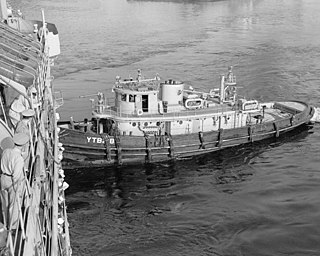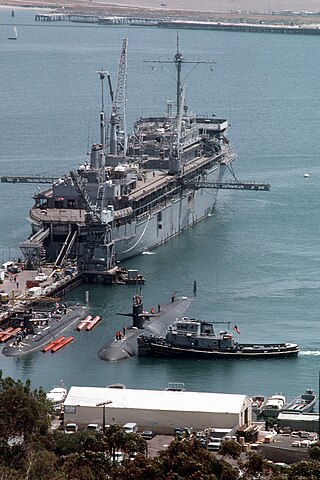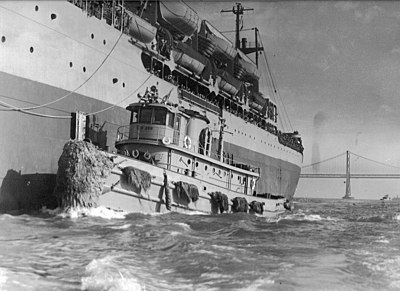
USS Achigan (YT/YTB-218) was a Cahto-class large harbor tug in the service of the United States Navy. A French-Canadian rendering of the word ashigan which, in Chippewa and Algonquian dialects, is the name of the smallmouth bass.

USS Pocahontas (YT/YTB/YTM-266), was a type V2-ME-A1 harbor tug that entered service in the United States Navy in 1943, and was sold in 1976. She was the third ship to bear the name Pocahontas.

Hoga (YT-146/YTB-146/YTM-146) is a United States Navy Woban-class district harbor tug named after the Sioux Indian word for "fish." After World War II, the tug was known as Port of Oakland and then City of Oakland when she was a fireboat in Oakland, California.
USS Bomazeen was originally the Bathgate, a tugboat built in 1919 at New York and purchased by the United States Navy on 29 December 1941 from the Meseck Towing Lines. She was renamed Bomazeen; designated YT 238 and placed in service on 4 February 1942.

USS Awatobi (YTB-264) was a harbor tugboat acquired by the United States Navy during the close of World War II. She was outfitted with two .50-caliber machine guns and assigned to the San Francisco Bay area where she provided tug services, and other harbor services as required.

USS Nokomis (YT-142/YTB-142/YTM-142) was a Woban-class harbor tug built in Bremerton, Wash, and assigned to Pearl Harbor, Hawaii, in 1940. Nokomis was present during the Japanese attack on Pearl Harbor, 7 December 1941. She was the first vessel on scene at the USS Arizona, and was called off by the officers on deck because of the imminent explosion of the battery below deck. It then left and helped beach the USS Nevada, with Hoga (YT-146), and YT-153. The beaching of the Nevada saved Pearl Harbor's mouth from being blocked. After that the USS Nokomis fought fires and dewatered the battleship USS California, for 3 days. This effort made the California salvageable, to be recommissioned again later in the war. Nokomis was also the last vessel to move the surviving YC-699 barge prior to the Japanese attack on Pearl Harbor. Post-war she continued serving Pearl Harbor ships until she was decommissioned in May 1973, and eventually sold for "scrap" to Crowley, in San Francisco. She was renamed Sea Serpent and served many years in the San Francisco Bay as a tug and fire boat. In 1989, after the Loma Prieta earthquake in the SF Bay area, Nokomis and Hoga fought fires alongside each other again.

USS Wenonah (YT-148/YTB-148/YTM-148) was a Woban-class district harbor tug which served during World War II in California ports, and continued her service until she was struck by the Navy in 1974. On 17 August 2009, the Wenonah sank while berthed at Treasure Island, CA, and was raised by the floating crane Left Coast Lifter on 28 August 2009.

The third USS Osceola (YT-129), previously USS YT-129, later YTB-129, later YTM-129, was a United States Navy harbor tug commissioned in 1938 and sold for scrapping in 1973.
USS Wampatuck (YT-337) later YTB-337 was United States Navy harbor tug in commission from 1942 to 1946.
USS Waneta (YT-384), later YTB-384, later YTM-384, was a United States Navy harbor tug in commission from 1944 to 1946 and from 1953 to 1974.
USS Washakie (YTB-386), laid down as YT-386, later YTM-386, was a United States Navy tug in commission from 1944 to 1946 and from 1953 to probably 1975.

Washtucna (YTB-826) was a United States Navy Natick-class large harbor tug named for Chief Washtucna of the Palus tribe.
USS Waubansee (YTB-366), originally YT-366, later YTM-366, was a United States Navy harbor tug commissioned in 1944 and stricken in 1983.
USS Evea (YT-458), originally the sixth USS Resolute (YT-458), later YTB-458, was a United States Navy tug in commission from 1943 to 1944.

USS Hiawatha (YT-265), later YTB-265, later YTM-265, was a type V2-ME-A1 harbor tug that entered service in the United States Navy in 1942, and was sold in 1987. She was the third ship to bear the name Hiawatha.

Manhattan (YTB‑779/YT-800) is a United States Navy Natick-class large harbor tug named for Manhattan, New York.
USS Ala (YT-139) was a United States Navy yard tug laid down on 23 September 1939 at Bremerton, Washington, by the Puget Sound Navy Yard; launched on 6 November 1939; and completed on 11 March 1940.

USS Cahto (YT/YTB-215) was the lead ship of the Cahto-class large harbor tug in the service of the United States Navy.
USS Wingina (YTB-395) is a tugboat that was laid down as District Harbor Tug YT-395. She was re-classified while still under construction as District Harbor Tug, Large YTB-395. After her commissioning, she served in the United States Navy from 1944 to 1980.

The Type V ship is a United States Maritime Commission (MARCOM) designation for World War II tugboats. Type V was used in World War II, Korean War, and the Vietnam War. Type V ships were used to move ships and barges. Type V tugboats were made of either steel or wood hulls. There were four types of tugboats ordered for World War II. The largest type V design was the sea worthy 186-foot (57 m) long steel hull, V4-M-A1. The V4-M-A1 design was used by a number of manufacturers; a total of 49 were built. A smaller steel hull tugboat was the 94-foot (29 m) V2-ME-A1; 26 were built. The largest wooden hull was the 148-foot (45 m) V3-S-AH2, of which 14 were built. The smaller wooden hull was the 58-foot (18 m) V2-M-AL1, which 35 were built. Most V2-M-AL1 tugboats were sent to the United Kingdom for the war efforts under the lend-lease act. The Type V tugs served across the globe during World War II including: Pacific War, European theatre, and in the United States. SS Farallon, and other Type V tugs, were used to help built Normandy ports, including Mulberry harbour, on D-Day, 6 June 1944, and made nine round trips to Normandy to deliver Phoenix breakwaters.










